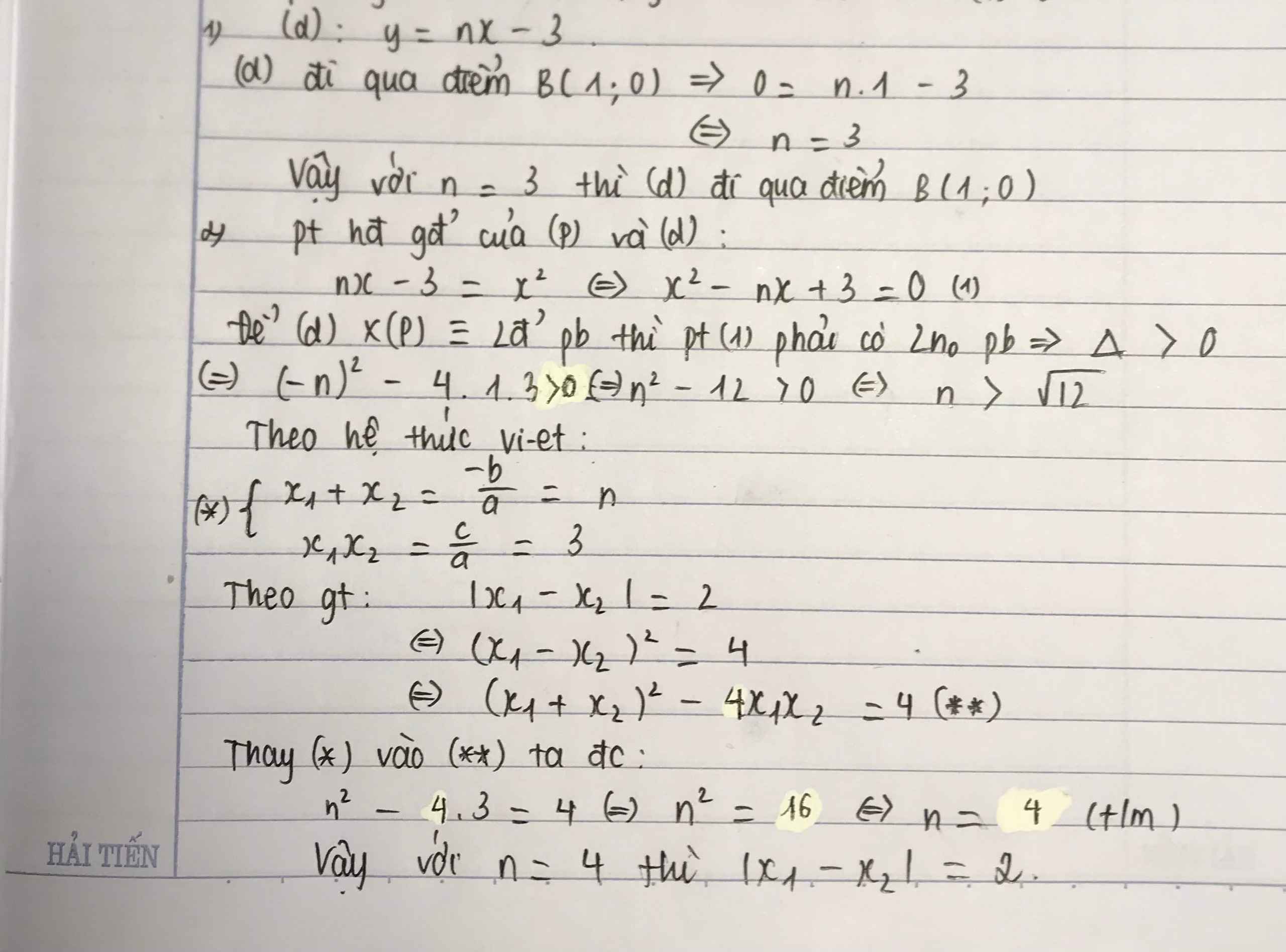Hãy nhập câu hỏi của bạn vào đây, nếu là tài khoản VIP, bạn sẽ được ưu tiên trả lời.

Phương trình hoành độ giao điểm là:
\(x^2-3x-m^2+1=0\)
\(a=1;b=-3;c=-m^2+1\)
\(\text{Δ}=9-4\cdot1\cdot\left(-m^2+1\right)\)
\(=9+4m^2-4=4m^2+5>0\)
Do đó: (P) luôn cắt (d) tại hai điểm phân biệt

a) Lập phương trình hoành độ giao điểm:
x2 = mx + 3
<=> x2 - mx - 3 = 0
Tọa độ (P) và (d) khi m = 2:
<=> x2 - 2x - 3 = 0
<=> \(\orbr{\begin{cases}x_1=3\\x_2=-1\end{cases}}\) => \(\orbr{\begin{cases}y_1=9\\y_2=1\end{cases}}\)
Tọa độ (P) và (d): A(3; 9) và B(-1; 1)
b) Để (P) và (d) cắt nhau tại 2 điểm phân biệt <=> \(\Delta>0\)
<=> (-m)2 - 4.1(-3) > 0
<=> m2 + 12 > 0 \(\forall m\)
Ta có: \(\frac{1}{x_1}+\frac{1}{x_2}=\frac{3}{2}\)
<=> 2x2 + 2x1 = 3x1x2
<=> 2(x2 + x1) = 3x1x2
Theo viet, ta có: \(\hept{\begin{cases}x_1+x_2=-\frac{b}{a}=m\\x_1x_2=\frac{c}{a}=-3\end{cases}}\)
<=> 2m = 3(-3)
<=> 2m = -9
<=> m = -9/2

a: Thay x=-1 và y=3 vào (d), ta được:
-2-m+1=3
=>-1-m=3
=>m=-4
b: PTHĐGĐ là;
1/2x^2-2x+m-1=0
=>x^2-4x+2m-2=0
Δ=(-4)^2-4(2m-2)
=16-8m+8=-8m+24
Để (d) cắt (P) tại hai điểm phân biệt thì -8m+24>0
=>m<3
x1x2(y1+y2)+48=0
=>x1x2(x1^2+x2^2)+48=0
=>(2m-2)[4^2-2(2m-2)]+48=0
=>(2m-2)(16-4m+4)+48=0
=>(2m-2)*(20-4m)+48=0
=>40m-8m^2-40+8m+48=0
=>-8m^2+48m+8=0
=>m=3+căn 10 hoặc m=3-căn 10

PTHĐGĐ là:
x^2-(2m+1)x+m^2+m-6=0
Δ=(2m+1)^2-4(m^2+m-6)
=4m^2+4m+1-4m^2-4m+24
=25>0
=>Phương trình luôn có hai nghiệm phân biệt
\(\left|x_1^2-x_2^2\right|=50\)
\(\Leftrightarrow\left|\left(2m+1\right)\right|\cdot\sqrt{\left(2m+1\right)^2-4\left(m^2+m-6\right)}=50\)
\(\Leftrightarrow\left|2m+1\right|\cdot5=50\)
=>|2m+1|=10
=>m=9/2 hoặc m=-11/2

1) ĐK \(\hept{\begin{cases}x\ne y\\y\ge-1\end{cases}}\)
Đặt \(\hept{\begin{cases}\frac{1}{x-y}=a\left(a\ne0\right)\\\sqrt{y+1}=b\left(b\ge0\right)\end{cases}}\)hệ phương trình đã cho trở thành
\(\hept{\begin{cases}2a+b=4\\a-3b=-5\end{cases}}\Leftrightarrow\hept{\begin{cases}2a+b=4\\2a-6b=-10\end{cases}}\Leftrightarrow\hept{\begin{cases}7b=14\\2a+b=4\end{cases}}\Leftrightarrow\hept{\begin{cases}a=1\\b=2\end{cases}\left(tm\right)}\)
\(\Rightarrow\hept{\begin{cases}\frac{1}{x-y}=1\\\sqrt{y+1}=2\end{cases}}\Leftrightarrow\hept{\begin{cases}x-y=1\\y+1=4\end{cases}}\Leftrightarrow\hept{\begin{cases}x=4\\y=3\end{cases}}\left(tm\right)\)
Vậy ...

1) ĐK \(\hept{\begin{cases}x\ge0\\y\ne1\end{cases}}\)
Đặt \(\hept{\begin{cases}2\sqrt{x}=a\left(a\ge0\right)\\\frac{1}{y-1}=b\left(b\ne0\right)\end{cases}}\)hệ phương trình đã cho trở thành
\(\hept{\begin{cases}a+3b=5\\2a-b=3\end{cases}}\Leftrightarrow\hept{\begin{cases}2a+6b=10\\2a-b=3\end{cases}}\Leftrightarrow\hept{\begin{cases}7b=7\\2a-b=3\end{cases}}\Leftrightarrow\hept{\begin{cases}a=2\\b=1\end{cases}\left(tm\right)}\)
\(\Rightarrow\hept{\begin{cases}2\sqrt{x}=2\\\frac{1}{y-1}=1\end{cases}}\Rightarrow\hept{\begin{cases}x=1\\y=2\end{cases}}\left(tm\right)\)
Vậy ...
1,\(\left\{{}\begin{matrix}2\sqrt{x}+\dfrac{3}{y-1}=5\\4\sqrt{x}-\dfrac{1}{y-1}=3\end{matrix}\right.\) ĐKXĐ:x≥o,y≠1
⇔\(\left\{{}\begin{matrix}4\sqrt{x}+\dfrac{6}{y-1}=10\\4\sqrt{x}-\dfrac{1}{y-1}=3\end{matrix}\right.\Leftrightarrow\left\{{}\begin{matrix}\dfrac{7}{y-1}=7\\4\sqrt{x}-\dfrac{1}{y-1}=3\end{matrix}\right.\)\(\Leftrightarrow\left\{{}\begin{matrix}y-1=1\\4\sqrt{x}-\dfrac{1}{y-1}=3\end{matrix}\right.\Leftrightarrow\left\{{}\begin{matrix}y-1=1\\4\sqrt{x}-\dfrac{1}{1}=3\end{matrix}\right.\Leftrightarrow\left\{{}\begin{matrix}y=2\\4\sqrt{x}=4\end{matrix}\right.\Leftrightarrow\left\{{}\begin{matrix}y=2\\\sqrt{x}=1\end{matrix}\right.\Leftrightarrow\left\{{}\begin{matrix}y=2\\x=1\end{matrix}\right.\left(TM\right)\)
vậy hpt đã cho có nghiệm duy nhất (x,y)=(1,2)
2,a, xét pthđgđ của (d) và (p) khi m=3:
x\(^2\)=3x-1⇔\(x^2-3x+1=0\)
Δ=(-3)\(^2\)-4.1.1=5>0
⇒pt có 2 nghiệm pb
\(x_1=\dfrac{3+\sqrt{5}}{2}\) ,\(x_2=\dfrac{3-\sqrt{5}}{2}\)
thay x=x\(_1\)=\(\dfrac{3+\sqrt{5}}{2}\) vào hs y=x\(^2\) ta được:
y=(\(\dfrac{3+\sqrt{5}}{2}\))\(^2\)=\(\dfrac{14+6\sqrt{5}}{4}\)⇒A(\(\dfrac{3+\sqrt{5}}{2},\dfrac{14+6\sqrt{5}}{4}\))
thay x=x\(_2\)=\(\dfrac{3-\sqrt{5}}{2}\) vào hs y=x\(^2\) ta được:
y=\(\left(\dfrac{3-\sqrt{5}}{2}\right)^2=\dfrac{14-6\sqrt{5}}{4}\)⇒B(\(\dfrac{3-\sqrt{5}}{2},\dfrac{14-6\sqrt{5}}{4}\))
vậy tọa độ gđ của (d) và (p) là A(\(\dfrac{3+\sqrt{5}}{2},\dfrac{14+6\sqrt{5}}{4}\)) và B (\(\dfrac{3-\sqrt{5}}{2},\dfrac{14-6\sqrt{5}}{4}\))
b,xét pthđgđ của (d) và (p) :
\(x^2=mx-1\)⇔\(x^2-mx+1=0\) (*)
Δ=(-m)\(^2\)-4.1.1=m\(^2\)-4
⇒pt có hai nghiệm pb⇔Δ>0
⇔m\(^2\)-4>0⇔m>16
với m>16 thì pt (*) luôn có hai nghiệm pb \(x_1,x_2\)
theo hệ thức Vi-ét ta có:
(I) \(\left\{{}\begin{matrix}x_1+x_2=m\\x_1.x_2=1\end{matrix}\right.\)
\(x_1,x_2\) TM \(x_2\)(x\(_1\)\(^2\)+1)=3
⇒\(x_2.x_1^2\)+\(x_2\)=3⇔\(x_2.x_1.x_1+x_2=3\)⇔(\(x_2.x_1\))(\(x_1+x_2\))=3 (**)
thay (I) vào (**) ta được:
1.m=3⇔m=3 (TM m≠0)
vậy m=3 thì (d) cắt (p) tại hai điểm pb có hoanh độ \(x_1.x_2\) TM \(x_2\)(\(x_1^2+1\))=3

Câu 1:
ĐKXĐ: \(\left\{{}\begin{matrix}x\ne1\\y\ne-2\end{matrix}\right.\)
Ta có: \(\left\{{}\begin{matrix}\dfrac{3}{x-1}-\dfrac{2}{y+2}=4\\\dfrac{2x}{x-1}+\dfrac{1}{y+2}=5\end{matrix}\right.\)
\(\Leftrightarrow\left\{{}\begin{matrix}\dfrac{3}{x-1}-\dfrac{2}{y+2}=4\\\dfrac{2x-2+2}{x-1}+\dfrac{1}{y+2}=5\end{matrix}\right.\Leftrightarrow\left\{{}\begin{matrix}\dfrac{3}{x-1}-\dfrac{2}{y+2}=4\\\dfrac{2}{x-1}+\dfrac{1}{y+2}=3\end{matrix}\right.\)
\(\Leftrightarrow\left\{{}\begin{matrix}\dfrac{6}{x-1}-\dfrac{4}{y+2}=8\\\dfrac{6}{x-1}+\dfrac{3}{y+2}=9\end{matrix}\right.\Leftrightarrow\left\{{}\begin{matrix}\dfrac{-7}{y+2}=-1\\\dfrac{6}{x-1}+\dfrac{3}{y+2}=9\end{matrix}\right.\)
\(\Leftrightarrow\left\{{}\begin{matrix}y+2=7\\\dfrac{6}{x-1}+\dfrac{3}{7}=9\end{matrix}\right.\Leftrightarrow\left\{{}\begin{matrix}y=5\\\dfrac{6}{x-1}=\dfrac{60}{7}\end{matrix}\right.\)
\(\Leftrightarrow\left\{{}\begin{matrix}x-1=\dfrac{7}{10}\\y=5\end{matrix}\right.\Leftrightarrow\left\{{}\begin{matrix}x=\dfrac{17}{10}\left(nhận\right)\\y=5\left(nhận\right)\end{matrix}\right.\)
Vậy: Hệ phương trình có nghiệm duy nhất là \(\left(x,y\right)=\left(\dfrac{17}{10};5\right)\)
Câu 2:
a) Phương trình hoành độ giao điểm của (P) và (d) là:
\(x^2=3x+m^2-1\)
\(\Leftrightarrow x^2-3x-m^2+1=0\)
\(\Delta=\left(-3\right)^2-4\cdot1\cdot\left(-m^2+1\right)\)
\(=9-4\left(-m^2+1\right)=9+4m^2-4=4m^2+5>0\forall m\)
Vậy: (d) luôn cắt (P) tại hai điểm phân biệt với mọi m